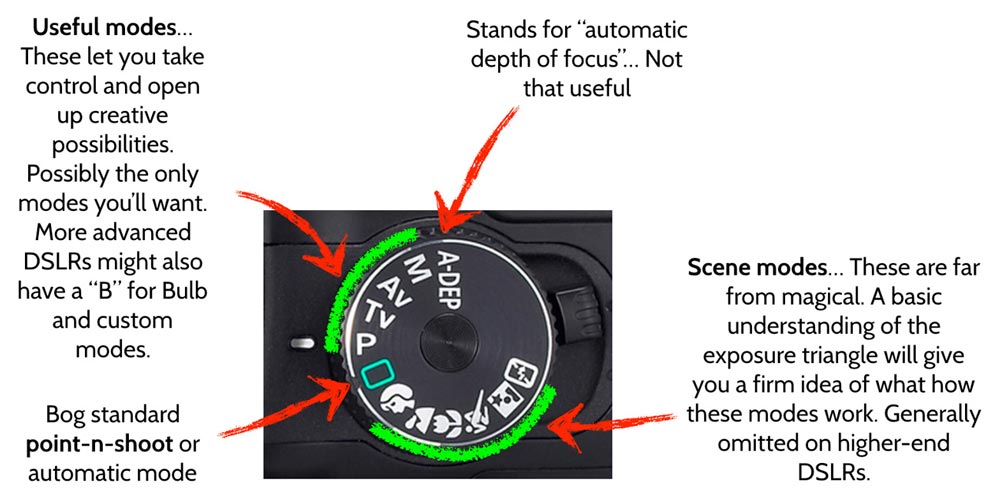Once you’re familiar with the exposure triangle, you’re ready to switch out of Auto mode. No matter what brand of camera you own, you should be able to find most of the following settings (Canon camera used in the example but settings are the same across makers).
Auto
The point-and-shoot mode. Camera takes full control over all settings. Not much else to be said.
Program Mode (“P”)
This is a kind of semi-automatic mode—a stepping point between Auto and other modes. Whereas you are unable to change any setting in Auto mode, P mode gives you more flexibility. You can adjust ISO and shutter speed, turn the flash on/off (if you have one), and adjust the white balance (handy if you’re not shooting in RAW), amongst other things. Others may disagree, but many experienced photographers will skip over this mode altogether and I would argue with good reason: “Av” and “Tv” modes are more intuitive and let you be creative more freely.
Aperture Priority (“Av”)
This mode gives you control over depth of field. You select the desired Aperture and ISO and then the camera automatically adjusts the shutter speed to ensure correct exposure. It is a useful setting, especially for portraits or landscapes.
Shutter Priority (“Tv”)
In this mode, with the ISO fixed, the camera adjusts aperture to ensure correct exposure at your desired shutter speed. This can be used when you want to capture a fast-moving scene, for instance at a sports event, or slow down to give the effect of motion, for example to smooth flowing water.
Note: Aperture Priority and Shutter Priority modes do allow you to set the ISO to auto; however, doing so means that in either mode two composites of your exposure triangle are now free to move around. For example, in Aperture Priority mode with the ISO set to auto, the camera can adjust either the shutter speed or the ISO to attain correct exposure and it will give priority to a low ISO at the cost of a longer exposure time, which may be an issue if you’re shooting hand-held at night.
Manual Mode (“M”)
In manual mode the camera just follows your command. You must set aperture, shutter speed and ISO settings manually before taking the shot—the exposure value (EV) scale will let you know whether the settings you have chosen will under-, correctly, or over-expose your image based upon the metering settings you have chosen. It is a useful and creative setting but with ISO out of “auto” can really only be used when you have time to plan and set up the shot. However, when ISO is set to “auto” the camera will adjust the ISO to attain correct exposure, letting you freely alter the aperture and shutter speed. You’ll need to keep an eye on the ISO level in this set up to make sure it doesn’t creep too high and let an unacceptable level of noise seep into the image.
Bulb Mode (on higher end DSLRs)
The vast majority of cameras will go to a maximum shutter speed of 30 seconds, but there are certain times (e.g. astrophotography) when an even longer shutter speed is desirable. In this case, you need to use the bulb mode. This is essentially an extension of manual mode that lets you determine exactly how long the shutter remains open, meaning that you’re probably going to have to do some quick mental arithmetic to work out the shutter speed for a correct exposure and then time it with the second hand on your watch. It is also useful when using a Big Stopper neutral density filter as even during the day required shutter times can exceed one minute.
Bulb mode requires you to press the shutter release button twice: once to open, once to shut.
Custom Modes (on higher end DSLRs)
There are of course many other settings beyond those on the dial. Metering, shooting mode (single shot, multiple shots), focus mode, and file format, to name but a few. We often find ourselves needing different settings for different scenes. For instance, spot metering for portrait shots or to shoot in JPEG if we just want to take some family snaps and not bother with the hassle of post-editing the RAW images. Constantly adjusting these settings through the menu system can be a pain (especially the change is six clicks away). Custom modes on cameras give us the ability to assign and save settings under custom slots so if you want some snapshots you don’t have to navigate the menu system for a few minutes, instead you can just twist the dial to “C1” (Canon) or “U1” (Nikon) and you’re done!

